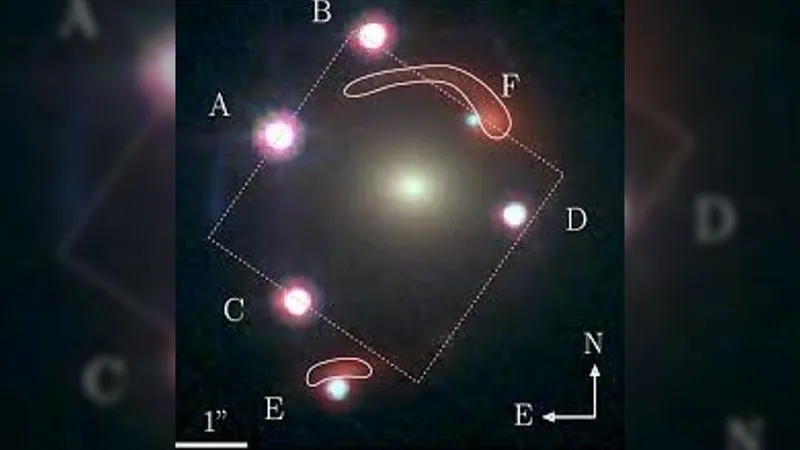
Breakthrough Discovery: James Webb Telescope Reveals First-Ever 'Einstein Zig-Zag' That Could Revolutionize Cosmology!
2024-11-19
Author: Liam
In a groundbreaking revelation, researchers have confirmed the existence of a previously hypothetical phenomenon known as the "Einstein zig-zag," using the impressive capabilities of the James Webb Space Telescope (JWST). This discovery marks the first example of light traversing through warped space-time in two distinct regions, shedding light on urgent problems facing cosmology today.
The Adventure Begins!
The adventure began in 2018, when astronomers stumbled upon a remarkable quartet of identical bright points located billions of light-years away, dubbed J1721+8842. Initially assumed to be mirror images of a single quasar—a bright galactic core sustained by a feeding black hole—scientists attributed this phenomenon to "gravitational lensing."
Gravitational lensing occurs when light from distant objects is bent as it navigates through the gravitational field of massive unobserved structures. This effect can replicate the image of the light source or stretch it into luminous formations akin to Einstein rings, named after Albert Einstein, who first posited this phenomenon in his 1915 theory of general relativity.
A Significant Update
In a significant update from a 2022 study, researchers discovered additional faint light points alongside the initial four, as well as a dim Einstein ring. This led to speculation that J1721+8842 might be a binary quasar, duplicated multiple times. However, a fresh analysis, submitted on November 8 to the preprint server arXiv, proposes that these six points of light are indeed from a single quasar, with the additional lights lensed around a second, more distant massive object that also produces the faint Einstein ring observed in earlier images.
The Einstein Zig-Zag
Remarkably, over two years of monitoring this celestial light show, the research team noted a time delay in the faintest duplicate light sources—indicating that light from these images travels a longer path. This zig-zag route occurs as light navigates around the two gravitationally lensed galaxies, leading researchers to coin the term "Einstein zig-zag" for this extraordinary configuration.
Why Does This Matter for Cosmology?
Einstein rings and other gravitationally lensed objects are invaluable to astronomers, offering insights into the mass of galaxies, potentially unlocking the mysteries of dark matter and the elusive nature of dark energy—forces that govern cosmic expansion. With the JWST’s unparalleled ability to detect these phenomena, scientists are not only uncovering distant cosmic treasures but also highlighting perplexing discrepancies in our understanding of the universe.
One such enigma currently captivating researchers is the "Hubble tension," which refers to the inconsistent expansion rates across various parts of the universe. The JWST has confirmed that these rates do not align with established cosmological models, posing a significant challenge to current theories.
However, the newly validated Einstein zig-zag might serve to reconcile this conflict. Its distinctive lensing configuration offers a unique opportunity to measure both the Hubble constant—the rate of cosmic expansion—and the mysterious properties of dark energy with unparalleled precision. Traditionally, scientists could only accurately determine one or the other, yet the Einstein zig-zag promises a pathway toward a more comprehensive understanding of the universe's expansion.
Conclusion
In summary, the James Webb Space Telescope has not only revealed a stunning cosmic phenomenon but also may be instrumental in answering some of the most profound questions in modern cosmology. This discovery is still undergoing peer review, but its potential to reshape our understanding of the cosmos cannot be understated. Keep your eyes on the stars—astronomy is about to take a thrilling leap forward!









 Brasil (PT)
Brasil (PT)
 Canada (EN)
Canada (EN)
 Chile (ES)
Chile (ES)
 España (ES)
España (ES)
 France (FR)
France (FR)
 Hong Kong (EN)
Hong Kong (EN)
 Italia (IT)
Italia (IT)
 日本 (JA)
日本 (JA)
 Magyarország (HU)
Magyarország (HU)
 Norge (NO)
Norge (NO)
 Polska (PL)
Polska (PL)
 Schweiz (DE)
Schweiz (DE)
 Singapore (EN)
Singapore (EN)
 Sverige (SV)
Sverige (SV)
 Suomi (FI)
Suomi (FI)
 Türkiye (TR)
Türkiye (TR)